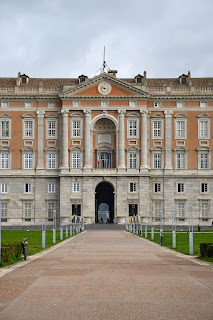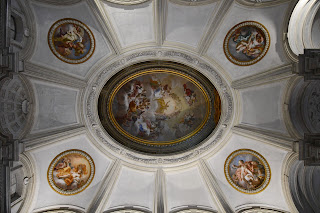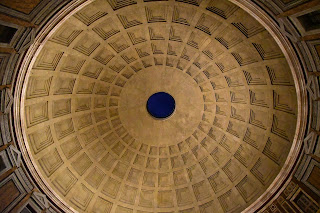Italy from South to North – Day 3: Caserta and Rome
Over the past two days, we finished our itinerary for Naples earlier than I expected, leaving us with a free morning before our trip to Rome. We decided to spend it at the Royal Palace of Caserta. Founded in 1752 by Charles VII of Naples, it was only completed in 1845, having briefly fallen into the hands of the Parthenopean Republic, the House of Bonaparte, and the House of Murat during the Napoleonic Wars. Like other royal palaces throughout Europe, Caserta was inspired by the sprawling complex of Versailles, whose sheer size allowed the monarch to permanently surround himself with his court and government.
Upon reaching Caserta,
we were struck by its sheer size. Although the palace does not look
particularly giant from the outside, one is met with a long row of mighty
arches immediately upon entering its front gate. Beyond these arches then unfurls
a long avenue, which rises into the nearby hill past a series of increasingly
elaborate fountains. The inside of the palace is decorated with many paintings
and golden mouldings; perhaps the most impressive are the giant ceiling
frescoes, which mostly depict allegories and scenes from legends.
We took a brief stroll
through the palace park but had to hurry back to the train station as soon as
we reached the first fountain. Mindful of the time, we knew that the train for
Rome only departed every hour, and we had to check in and leave our bags at our
hotel before proceeding to the Colosseum.
We arrived in Rome
almost exactly at twelve and ate lunch at the Mercato Centrale. Directly
adjoining the station, the place had been recommended to me by my Italian work
colleague as a place to get good food for acceptable prices – a promise that
the market certainly fulfilled. Aron and I found a restaurant where we shared
two delicious plates of linguine with fresh black truffles and calamari pasta
in truffle-flavoured cacio e pepe.
After leaving our bags at our hotel, we made a brief visit to the Papal Basilica of Santa Maria Maggiore just across the road. We were very impressed by its lavishness and by the precision of the mosaics. It was much more peaceful than the Colosseum and the entire surrounding area, which even in the middle of November were teeming with tourists. Only by the time that we reached Trajan’s Forum did the traffic ease a little, but then we entered the thick of it again at Piazza Navona and spent some twenty minutes waiting in line to enter the Pantheon. It is a shame that none of the original pagan statues are there and that the interior of the magnificent building seems more like that of a second-rate church.
Our last stop for the day was the beautiful Basilica of Santa Maria in Trastevere, which lies just across the Tiber in the western end of the city. Once we had finished gawking at its golden mosaics, we felt it would be a good idea to pre-empt the evening rush, eat dinner, and head home. We tried a few Roman specialties: a pinsa and a baked artichoke, which we coupled with a seafood pasta.































































Comments
Post a Comment